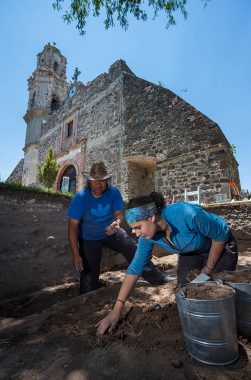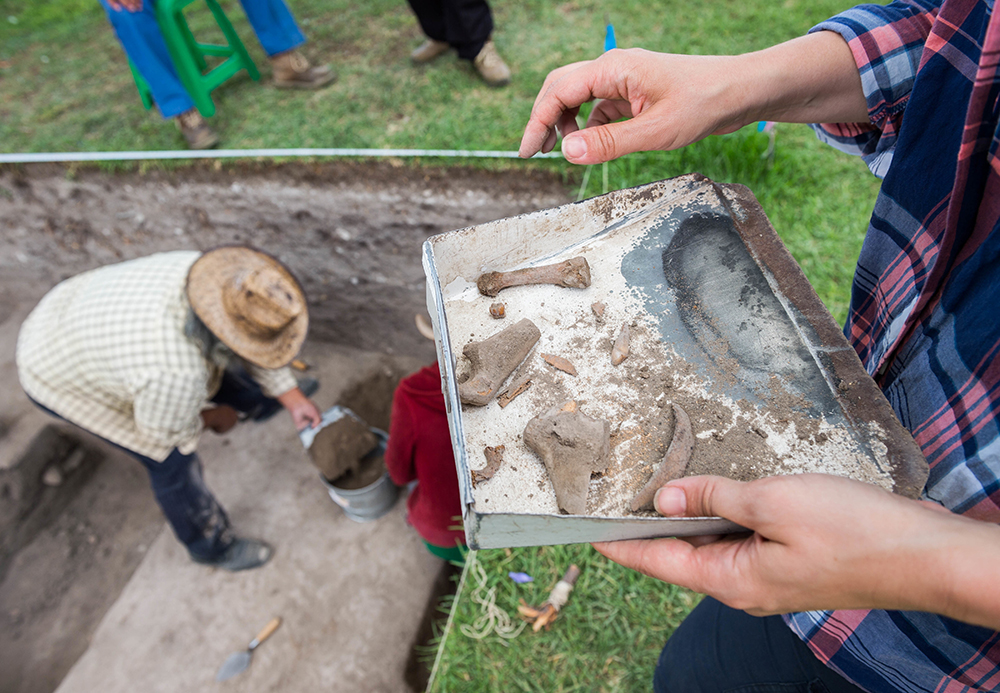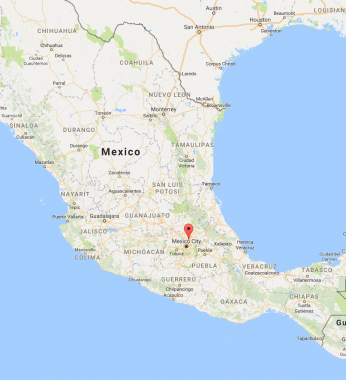Colgate archaeologists burrow into the history of a small Mexican village
Successful archaeologists have unending patience, an open mind, an eye for detail, and a deft touch. They learn all of this by doing the work. To the untrained eye, soil is soil. But an archaeologist with a spray bottle and a track history in the trenches will spy the barely discernable outline of a burial pit or the tracings of a wall in that dry dust.
“You need to be in the dirt to see it,” says anthropology professor Kristin De Lucia.
So, last summer, De Lucia took Class of 2019 members Emily Kahn, Cameron Pauly, Hannah Post, and Audrey Swift to the village of San Miguel Xaltocan, just north of Mexico City. She put them in the dirt of a once-thriving agricultural community.
De Lucia is no stranger to San Miguel Xaltocan. She began digging there as a grad student and has continued since joining the Colgate faculty in 2016, using funds from the National Science Foundation and Colgate. Pauly, Post, and Swift are anthropology majors — archaeologists in training. They started the project as a scholarly job shadow. Kahn, a history major and museum studies minor, joined up to learn the origins of the art works she hopes someday to curate.

Emily Kahn ’19 and local archaeologist Luis González put down their trowels and pick up history buried in the shadow of the Iglesia de San Miguel Xaltocan.
The students worked alongside De Lucia, co-director Enrique Rodríguez-Alegría and other faculty members from the University of Texas (UT) at Austin, and locals outside the Iglesia De San Miguel Xaltocan. Twine defined the 6- x 4-meter trench in the yard. They swept aside layers of soil, 10 centimeters per stratum. After each layer, work paused and the students measured the diagonal of the rectangle to ensure that the walls remained parallel.
They sifted and screened to reveal shards of pottery, jawbones of faithful dogs, walls of adobe brick, and the bodies of long-dead villagers. Meanwhile, the grackles sang along from the limbs of the old acacia tree, its broad canopy blocking out the hot Mexican sunshine.
Traditionally, where you see a Colonial-era church aboveground in Mexico, you would expect to find a pre-colonial temple underground. The massive stones of an indigenous pyramid provided ready-made foundations for Catholic structures imposed on the population by their conquerors.
Layer by layer, De Lucia and the students have turned back time, and although the churchyard in San Miguel Xaltocan has yielded up any number of pottery shards and pet teeth, it does not provide evidence of such a temple. De Lucia has uncovered a mystery.
Why did Spanish invaders place the iglesia on this spot if not to take advantage of sturdy masonry? The question will keep her busy as she continues her research in Xaltocan next summer — and as she analyzes the team’s other finds, detailed here.

Kristin De Lucia, assistant professor of anthropology, holds a tray of assorted bones that were found.
Expect the unexpected
Xaltocan resident Polo Arellano lives just up the street from the church, past the bodega and across the street from the school. Last year, after a rainstorm, the old fig tree in Arellano’s garden fell over, revealing the walls of an ancient home. He had worked for archaeologists before, so he invited De Lucia and her colleagues to conduct an impromptu dig in his backyard.
Under the wall, among the vases, bowls, and statuettes, Post and UT grad students find the body of a child. The evidence suggests that this young person died circa 1200. Like so many who never made it to adulthood in Xaltocan, the child was carefully buried beneath the walls of its house. Its parents scooped out the dirt and clay at the bottom, carefully placed the body inside, and resealed the void.
Two thousand years ago, Xaltocon was a green island in the middle of a broad blue lake. The villagers dredged the bottom, piling up silt to create room for housing and some of the most fertile farmland on earth. They kept it in production throughout the year thanks to sustainable agriculture practices. When the Spaniards arrived in force, they drained the lake and killed 95 percent of the native population.
Regardless of how long this burial process originally took, removing the child will take all day. Before starting their work, the archaeologists build a small stone shrine at the edge of the trench and light a candle.
Burial excavations go straight down, following the contours of the grave. Forget the width of the trench. If they stick to that protocol, researchers might mix artifacts from various time periods and defeat the purpose of the layering process. Discomforts of the job: long hours on your knees and wearing latex gloves for extended periods of time in 85-degree heat.
The things they buried
Pauly, Post, Swift, and Kahn have varying experience with the Spanish language. This trip forced them to engage with the language and culture in a way that most undergraduates never enjoy.
Bringing artifacts back to the museum-holding facility after a day of digging, the four are treated to an impromptu lecture on dentistry as an aid to identifying the age of jaw bones. Omar Marquez Portillo, physical anthropology and dentistry specialist, speaks to them in English, but occasionally turns to his native language as he talks about root structures that disappear as baby teeth mature. An X-ray of this jawbone could show the adult teeth hidden below, providing evidence for an even more precise age.
Across town, the team rents an empty house for use as a lab. Fire ants swarm outside in the yard. Inside, tables are stacked with cloth bags, labeled by location and layer, containing the shards, buttons, and other relics that tell the material story of Xaltocan.
Down in the trench, a few archetypal vessels are found. Large jars called “ollas” with iconic handles were used for storing or boiling liquid. Comals, a type of flat griddle, were used for making tortillas and possibly frying fish. Copas were used for drinking alcohol or chocolate, which would have been a kind of narcotic. There are also bowls, some decorated and some plain. The plain dishes were for storage and the decorated pots were used for company.
You can learn plenty about a culture from its pottery. De Lucia and her team have sent shards like these off for analysis. They want to know what kind of clay was used to make the pottery — was it local or were the people of Xaltocan using pots, plates, and cups purchased through trade from other cities in the Mexico basin? By breaking down the chemical compounds on the surface of some shards, they can determine varieties of food that were stored or cooked in the vessel.
The proportion of cookware to serving vessels in an excavation layer can tell you how much partying the population pursued. As different layers give up different pottery shards, the archaeologists can begin to ask more complex questions: How does the pottery change over time? How does it vary between houses? The answers allow experts to infer details about shifts in economics and more.
This is the life of an archeologist:
Some days, you find a burial. Others, you find broken bits of unpainted bowls. No matter what you uncover, it shows itself slowly, one broom whisk at a time. While the work of a Colgate classroom is challenging and rewarding, learning by doing in Xaltocan is something altogether different.
“You can know everything there is to know about archaeological theory, but you still have to understand how to apply that in the field,” Pauly says, “I will admit that it was difficult at the beginning of the excavation, as we got a grasp on how to excavate properly and look for details. But gradually you come to understand more of the nuance of fieldwork. There’s a real thrill involved in fieldwork — of excavation and discovery, and of piecing together theories from the data you’ve unearthed — that is hard to beat.”
View the full gallery of their trip and the discoveries they unearthed.






















































